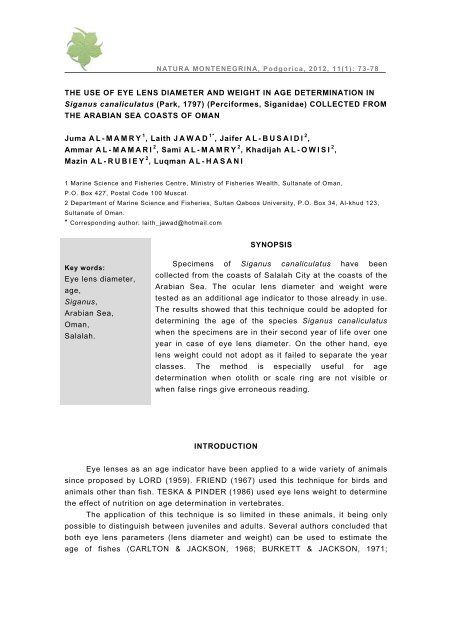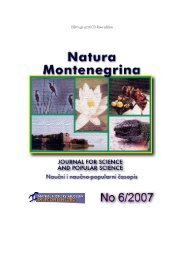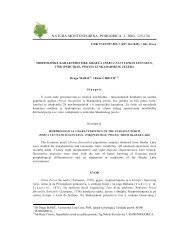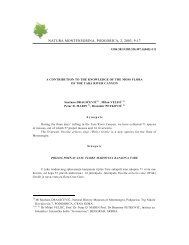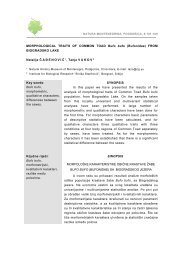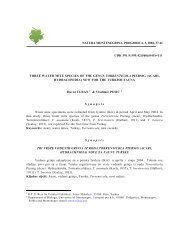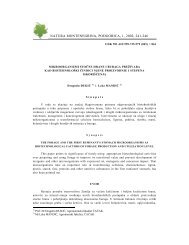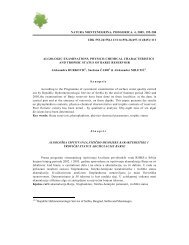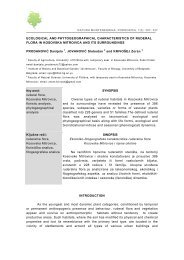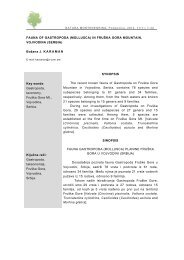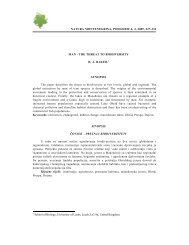THE USE OF EYE LENS DIAMETER AND WEIGHT IN AGE ...
THE USE OF EYE LENS DIAMETER AND WEIGHT IN AGE ...
THE USE OF EYE LENS DIAMETER AND WEIGHT IN AGE ...
Create successful ePaper yourself
Turn your PDF publications into a flip-book with our unique Google optimized e-Paper software.
NATURA MONTENEGR<strong>IN</strong>A, Podgorica, 2012, 11(1): 73-78<br />
<strong>THE</strong> <strong>USE</strong> <strong>OF</strong> <strong>EYE</strong> <strong>LENS</strong> <strong>DIAMETER</strong> <strong>AND</strong> <strong>WEIGHT</strong> <strong>IN</strong> <strong>AGE</strong> DETERM<strong>IN</strong>ATION <strong>IN</strong><br />
Siganus canaliculatus (Park, 1797) (Perciformes, Siganidae) COLLECTED FROM<br />
<strong>THE</strong> ARABIAN SEA COASTS <strong>OF</strong> OMAN<br />
Juma AL-MAMRY 1 , Laith J A W A D 1* , Jaifer AL-BUSAIDI 2 ,<br />
Ammar AL-MAMARI 2 , Sami AL-MAMRY 2 , Khadijah AL-OWISI 2 ,<br />
Mazin AL-RUBIEY 2 , Luqman A L - H A S A N I<br />
1 Marine Science and Fisheries Centre, Ministry of Fisheries Wealth, Sultanate of Oman,<br />
P.O. Box 427, Postal Code 100 Muscat.<br />
2 Department of Marine Science and Fisheries, Sultan Qaboos University, P.O. Box 34, Al-khud 123,<br />
Sultanate of Oman.<br />
* Corresponding author: laith_jawad@hotmail.com<br />
SYNOPSIS<br />
Key words:<br />
Eye lens diameter,<br />
age,<br />
Siganus,<br />
Arabian Sea,<br />
Oman,<br />
Salalah.<br />
Specimens of Siganus canaliculatus have been<br />
collected from the coasts of Salalah City at the coasts of the<br />
Arabian Sea. The ocular lens diameter and weight were<br />
tested as an additional age indicator to those already in use.<br />
The results showed that this technique could be adopted for<br />
determining the age of the species Siganus canaliculatus<br />
when the specimens are in their second year of life over one<br />
year in case of eye lens diameter. On the other hand, eye<br />
lens weight could not adopt as it failed to separate the year<br />
classes. The method is especially useful for age<br />
determination when otolith or scale ring are not visible or<br />
when false rings give erroneous reading.<br />
<strong>IN</strong>TRODUCTION<br />
Eye lenses as an age indicator have been applied to a wide variety of animals<br />
since proposed by LORD (1959). FRIEND (1967) used this technique for birds and<br />
animals other than fish. TESKA & P<strong>IN</strong>DER (1986) used eye lens weight to determine<br />
the effect of nutrition on age determination in vertebrates.<br />
The application of this technique is so limited in these animals, it being only<br />
possible to distinguish between juveniles and adults. Several authors concluded that<br />
both eye lens parameters (lens diameter and weight) can be used to estimate the<br />
age of fishes (CARLTON & JACKSON, 1968; BURKETT & JACKSON, 1971;
Natura Montenegrina 11(1), 2012<br />
CRIVILLI, 1980; SALEEM et al., 1990; DOUGLAS, 1987; AL-HASSAN et al., 1991,<br />
1992; AL-HASSAN & AL-SAYAB, 1994; CONIDES & AL-HASSAN, 2000; JAWAD,<br />
2001, 2003, 2004; JAWAD et al., 2001).<br />
Age determination is an important step in the process of studying growth in<br />
fish species. The method involves counting of scale or otolith annuli and usually<br />
requires the measurements of a large number of specimens (FLETCHER, 1991).<br />
Otolith and scale readings require a variable and considerable effort to prepare each<br />
specimen and even then the readings are subject to both systematic and random<br />
errors in interpretation and require independent validation (BEAMISH, 1979). Thus,<br />
a considerable time is needed to acquire the skill necessary for consistent<br />
interpretation of the materials. In addition, extra readings are usually needed in<br />
order to verify the age assigned to a specimen (S<strong>AND</strong>ERMANN, 1969).<br />
The aim of this study is to determine the validity of the eye lens diameter and<br />
weight as age indicators in the Arabian Sea fish, S. canaliculatus and to establish a<br />
faster method for ageing fishes beside the conventional methods of scale and<br />
otolith.<br />
MATERIAL <strong>AND</strong> METHODS<br />
Specimens of Siganus canaliculatus (387) were collected from the coasts of<br />
Salalah City at the Arabian Sea during the period January 2010-August 2010. Fishes<br />
were taken to the laboratory and the diameter and weight of the eye lens were taken<br />
to the nearest mm and g respectively following the procedure of JAWAD et al.<br />
(2004). The lenses were extracted, dried at room temperature (25°C). The<br />
measurement of the lens in each side of the animal was kept separate. The large<br />
bone such as operculum and preoperculum were used to determine the age<br />
following AL-HASSAN & AL-HASSAN (1994). The bones on both left and right sides<br />
were twice read independently, using an ordinary dissecting microscope for<br />
verification. One way analysis of variance followed by Duncan's multiple range test<br />
(HARRAWAY, 1997) were applied to test the differences between the total length of<br />
the fish and its age.<br />
GERK<strong>IN</strong>G (1966) showed how different environmental factors could alter the<br />
growth rate in the bluegill Lepomis macrochirus Rafinesque, 1819 and SWEDBERG<br />
(1965) summarized the various growth rates of drum, Aplodinotus grunniens<br />
Rafinesque, 1820 from different areas in the United States. Environmental<br />
conditions must be considered in applying the lens technique (BURKETT &<br />
JACKSON 1971). CRIVILLI (1980), working on carp, stated that in the reproductive<br />
period energy is transformed from somatic to gonadal growth.<br />
74
Al-Mamry et al.: <strong>THE</strong> <strong>USE</strong> <strong>OF</strong> <strong>EYE</strong> <strong>LENS</strong> <strong>DIAMETER</strong> <strong>AND</strong> <strong>WEIGHT</strong> <strong>IN</strong> <strong>AGE</strong> . . .<br />
RESULTS <strong>AND</strong> DISCUSSION<br />
The age of Siganus canaliculatus samples ranging from less than one year<br />
(young of the year) to two year. The total length observed in different age classes of<br />
the species in question showed that body size is variable within an age class and<br />
considerable overlap exists between these age classes (P> 0.05). This is considered<br />
as one of the reasons for using eye lens diameter as an age indicator (Figure 1).<br />
Figure 1. Total length vs<br />
age (determined from<br />
opercular bone) Siganus<br />
canaliculatus Vertical bars<br />
represent range of fish<br />
total length and horizontal<br />
lines represent mean fish<br />
length.<br />
The average lens diameter showed a considerable increase with age for the<br />
species under consideration (Figure 2). This increment is obvious in fishes<br />
belonging to age class I & II (P>0.05). The overlap in lens diameter between young<br />
of the year class and Classes I invalidates any accurate age determination for fish<br />
samples younger than age group I. CARLTON & JACKSON (1968) and JAWAD<br />
(2001) reached the same conclusion with carp and tilapia respectively when working<br />
on a small sample size and with fish not older than five years. Thus, only specimens<br />
of age group II year old can be effectively separated from the remaining age groups<br />
on the basis of lens diameter (P
Natura Montenegrina 11(1), 2012<br />
Figure 2. Lens diameter vs<br />
age (determined from<br />
opecular bone) of Siganus<br />
canaliculatus Vertical bars<br />
represent total range of<br />
lens diameter and<br />
horizontal lines represent<br />
mean diameter.<br />
Figure 3. Lens weight vs<br />
age (determined from<br />
opercular bone) of Siganus<br />
canaliculatus Vertical bars<br />
represent range of lens<br />
weight and horizontal lines<br />
represent mean lens<br />
weight.<br />
Since the increment in lens diameter and weight is closely correlated with<br />
somatic growth, the variation in individual reproductive development could result in<br />
an increased variation in lens weight within an annual group. In other words, the<br />
growth rate during the reproductive period drops down due to the concentration of<br />
body on the reproductive metabolism. This drop in growth rate will affect the<br />
different parts of the fish body including the eye lens. This will end up giving<br />
variable results not in accordance with the general growth rate of the individual.<br />
76
Al-Mamry et al.: <strong>THE</strong> <strong>USE</strong> <strong>OF</strong> <strong>EYE</strong> <strong>LENS</strong> <strong>DIAMETER</strong> <strong>AND</strong> <strong>WEIGHT</strong> <strong>IN</strong> <strong>AGE</strong> . . .<br />
CONCLUSIONS<br />
The lens diameter technique could be adopted for determining the age of the<br />
specimens in their second year of life. On the other hand, eye lens weight failed to<br />
separate the year classes. The method is especially useful for age determination<br />
when otolith or scale ring are not visible or when false rings give erroneous reading.<br />
ACKNOWLEDGEMENTS<br />
We would also like to thank the Ministry of Agriculture and Fisheries, the Agriculture<br />
and Fisheries Development Fund and the Marine Science and Fisheries Centre for giving us<br />
the opportunity to work on the fish samples within the qualitative and quantitative distribution<br />
of marine organisms in Sultanate of Oman and to provide the appropriate financial support.<br />
REFERENCES:<br />
AL-HASSAN L.A. J., AL-DAHAM N. K., HASSAN S.S. 1991. Eye lens as an age indicator in<br />
Mystus pelusius (Bagridae). - Cybium, 15: 171-172.<br />
AL-HASSAN L.A. J., AL-DUBAIKEL A. Y., WAHAB N.K. 1992. Ocular lens diameter as an<br />
age indicator in two teleost fishes. - Acta Hydrobiologica, 34: 275-279.<br />
AL-HASSAN L. A. J., AL-SAYAB A. A. 1994. Eye lens diameter as an age indicator in the<br />
catfish, Silurus triostegus. - Pakistan Journal Zoology, 26: 81-82.<br />
BEAMISH R. J. 1979. Differences in age pf Pacific hake, Merluccius productus using whole<br />
otoliths and sections of otoliths. - Journal of Fisheries Research Board Canada, 36:<br />
141-151.<br />
BURKETT D. D., JACKSON W. B. 1971. The eye lens as an age indicator in freshwater<br />
drum. - American Midland Naturalist, 85: 222-225.<br />
CARLTON W.G., JACKSON W.B. 1968. The eye lens as an age indicator in carp. - Copeia,<br />
1: 633-636.<br />
CONIDES A.J., AL-HASSAN L.A. J. 2000. Using eye lens diameter as age indicator of young<br />
Lithognathus mormyrus and Diplodus vulgaris. - Naga ICLARM Quarter, 23: 21-22.<br />
CRIVILLI A. 1980. The eye lens weight and age in the common carp. Cyprinus carpio L. -<br />
Journal of Fish Biology, 16: 469-473.<br />
DOUGLAS R.H. 1987. Ocular lens diameter as an indicator of age in brown trout, Salmo<br />
trutta. - Journal of Fish Biology, 31: 835-836.<br />
FLETCHER W. J. 1991. A test of the relationship between otolith weight and age for the<br />
pilchard, Sardinops neopilchardus. - Canadian Journal of Fisheries and Aquatic<br />
Science, 48: 35-38.<br />
FRIEND M. 1967. Some observations regarding eye-lens weight as a criterion of age in<br />
animals. - New York Fish and Game, 14: 91-121.<br />
77
Natura Montenegrina 11(1), 2012<br />
GERK<strong>IN</strong>G S.D. 1924. Animal growth cycle, growth potential and growth compensation in the<br />
bluegill sunfish in Northern Indiana lakes. - Journal of Fisheries Research Board of<br />
Canada, 23: 1924-1956.<br />
HARRAWAY J. 1997. Introductory statistical methods for biological, health and social<br />
sciences. - University of Otago Press, Dunedin, New Zealand, 342pp.<br />
JAWAD L.A. 2001. Eye lens diameter and age determination in the tilapia fish, Tilapia zilli. -<br />
Biologia Bratislavia, 56: 573-575.<br />
JAWAD L. A. 2003. Ocular lens diameter and weight as age indicators in two teleost fishes<br />
collected from the Red Sea of Yemen. - Zoology in the Middle East, 29: 59-62.<br />
JAWAD L. 2004. A. Preliminary study on the use of eye lens diameter and weight as an age<br />
indicator in two cyprinid fishes collected from Basrah, Iraq. - Bolletino de Museo<br />
regionale Science natural del Torino, 21: 51-158.<br />
JAWAD L. A., TAHER M. M., NAJDI H.M.H. 2001. Age and asymmetry studies on the Indian<br />
mackerel, Rastrelliger kanagurta (Osteichthyes: Scombridae) collected from the Red<br />
Sea coast of Yemen. - Indian Journal of Marine Science, 30: 180-182.<br />
LORD R. D. 1959. The lens as an indicator of age in cottontail rabbits. - Journal of Wildlife<br />
Management, 23: 358-360.<br />
SALEEM S.D., AL-HASSAN L. A. J., MELKONIAN M. K. 1990. The eye lens weight and age<br />
in some fish species collected from Basrah waters, Iraq. - Proceedings of the 15 th<br />
International Conference for Statistics, Computer Science, Social and Demographic<br />
Research, Cairo, 17-22.<br />
S<strong>AND</strong>ERMAN E. J. 1969. Age determination and growth rate in redfish, Sebastes sp. from<br />
selected areas around Newfoundland. - Northwest Atlantic Fish Research Bulletin, 6:<br />
79-106.<br />
SWEDBERG D.V. 1965. Age and rate of growth of freshwater drum in Lewis and Clark lakes,<br />
Missouri River. - Proceeding of South Dakota Academy of Science, 44: 160-168.<br />
TESKA W. R., P<strong>IN</strong>DER T.E. 1986. Effect of nutrition on age determination using eye lens<br />
weights. - Growth, 50: 362-370.<br />
WOOTTON R. J. 1990. Ecology of teleost fishes. – Publisher, London, 450pp.<br />
Received: 29 November 2011.<br />
Accepted: 24 February 2012.<br />
78


